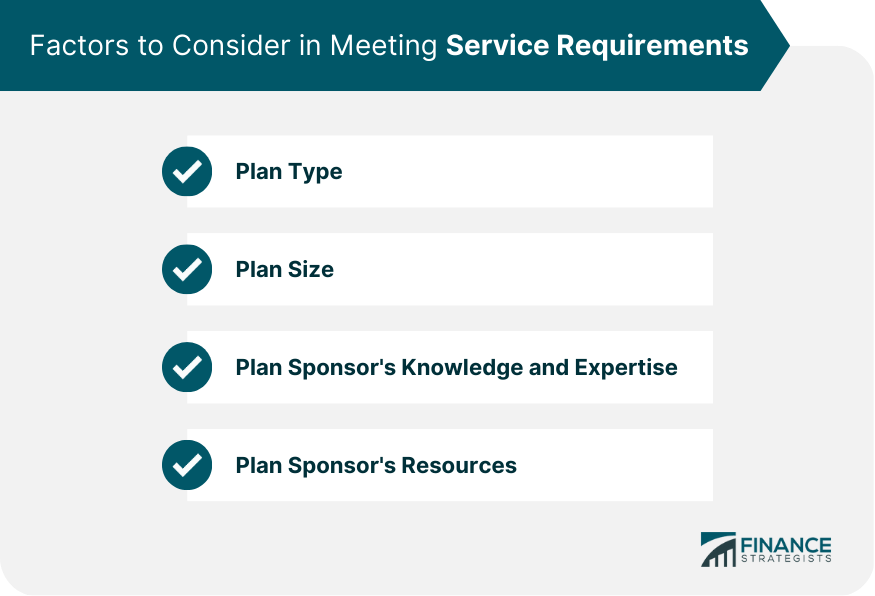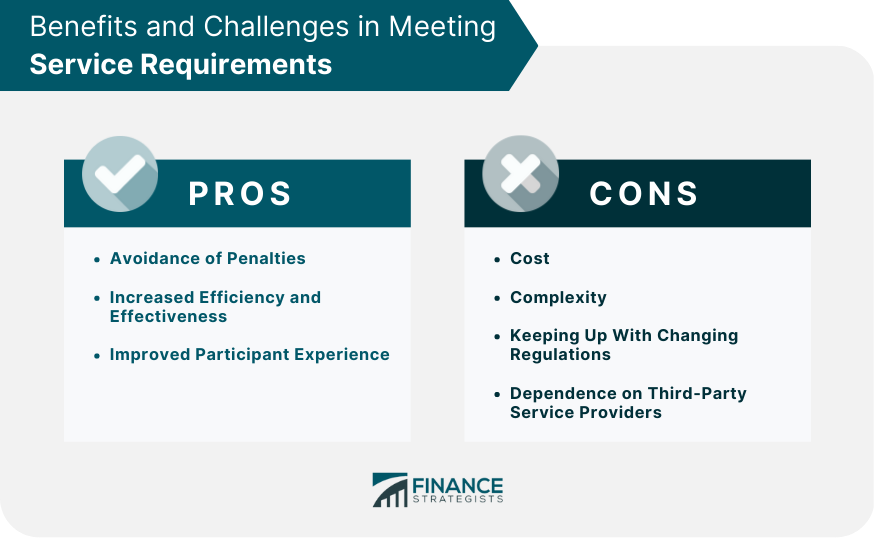Service requirements refer to the different components of retirement planning and compliance that require specialized knowledge and expertise. Service requirements can vary depending on the type of retirement plan and the regulatory requirements. Meeting the service requirement is crucial for the success of retirement planning and compliance. Service requirements are essential in ensuring that retirement planning is effective and meets regulatory compliance standards. Plan administration is the management of the day-to-day operations of a retirement plan. It involves tasks such as maintaining plan records, preparing and distributing plan documents, and ensuring compliance with regulatory requirements. Plan administrators ensure that the plan operates within the regulatory framework and that the plan participants receive the benefits they are entitled to. Recordkeeping involves maintaining accurate and complete records of retirement plan transactions. It ensures that the plan participants receive accurate and timely information about their plan benefits. Recordkeeping also helps plan administrators to comply with regulatory requirements. Compliance testing is the process of testing whether a retirement plan complies with regulatory requirements. It involves various tests such as coverage testing, top-heavy testing, and nondiscrimination testing. Compliance testing ensures that the plan benefits are distributed fairly among plan participants. Plan document maintenance involves ensuring that the retirement plan document is up to date and complies with regulatory requirements. It includes tasks such as updating plan documents when regulatory requirements change, ensuring that the plan document is consistent with plan operations, and ensuring that the plan document accurately reflects the plan's terms. Different types of retirement plans have different service requirements. For example, a defined benefit plan requires more specialized knowledge and expertise than a defined contribution plan. Meeting service requirements for different types of plans requires different levels of expertise and resources. The size of a retirement plan can also influence the service requirements. Larger retirement plans may require more specialized knowledge and expertise to administer than smaller plans. Meeting service requirements for larger retirement plans requires more resources and expertise. The knowledge and expertise of the plan sponsor can also influence the service requirements. If the plan sponsor has a good understanding of retirement planning and compliance, they may require fewer specialized services. However, if the plan sponsor has limited knowledge and expertise, they may require more specialized services. The resources available to the plan sponsor can also influence the service requirements. Plan sponsors with limited resources may require more cost-effective service solutions, while plan sponsors with more resources may be able to invest in more specialized services. Meeting service requirements in retirement planning and compliance helps plan sponsors to avoid penalties for non-compliance. Failure can result in severe penalties, such as fines, taxes, and even plan disqualification. Meeting service requirements ensures that the plan sponsor complies with regulatory requirements and avoids penalties. Meeting service requirements in retirement planning and compliance helps plan sponsors to operate the plan efficiently and effectively. It ensures that plan operations are consistent with regulatory requirements, and plan participants receive accurate and timely information about their plan benefits. Increased efficiency and effectiveness help to improve the plan sponsor's reputation and build trust with plan participants. Meeting service requirements in retirement planning and compliance helps to improve the participant experience. It guarantees that plan participants receive accurate and timely information about their plan benefits and that their benefits are distributed fairly. Improved participant experience helps to build trust and loyalty among plan participants and improves their retirement outcomes. Meeting service requirements in retirement planning can be expensive. Specialized services require expertise, which can be costly. Plan sponsors may need to invest significant resources to meet service requirements. Regulatory requirements can be challenging to navigate, and specialized knowledge is required to comply with these requirements. Plan sponsors may require assistance to meet service requirements. Meeting service requirements in retirement planning and compliance requires staying up to date with changing regulations. Regulatory requirements can change frequently, and plan sponsors must ensure that their plan operations remain compliant with these changes. Plan sponsors may not have the resources or expertise to meet service requirements on their own, and they may need to outsource specialized services. Dependence on third-party service providers can be challenging to manage and can increase the plan sponsor's cost. Plan sponsors can meet service requirements by investing in in-house plan administration. This allows plan sponsors to have direct control over plan operations, which can help to reduce costs. In-house plan administration requires specialized knowledge and expertise, which can be challenging to manage. Third-party administrators have specialized knowledge and expertise in retirement planning and compliance, which can help plan sponsors to reduce costs and manage complexity. Outsourcing to third-party administrators requires careful management to ensure that the plan sponsor's objectives are met. Plan sponsors can meet service requirements by investing in compliance technology. Such tools help plan sponsors to automate compliance tasks, such as recordkeeping and compliance testing, which can help to reduce costs and manage complexity. Investing in compliance technology requires significant upfront investment, and plan sponsors must ensure that the technology meets their specific needs. Meeting service requirements in retirement planning is critical for ensuring a successful and financially stable retirement. Service requirements include various components, such as plan administration, recordkeeping, compliance testing, and plan document maintenance. These requirements necessitate specialized knowledge and expertise, and plan sponsors must consider various factors, such as plan type, size, and resources, to meet them. Meeting service requirements provides numerous benefits, such as avoidance of penalties, increased efficiency and effectiveness, and improved participant experience. However, there are also challenges to meeting service requirements, such as cost, complexity, and keeping up with changing regulations. Plan sponsors can address these challenges by investing in in-house plan administration, outsourcing plan administration to third-party administrators, or investing in compliance technology. Ultimately, meeting service requirements in retirement planning and compliance requires a strategic approach that balances cost, expertise, and regulatory compliance to ensure a financially stable and comfortable retirement for plan participants.What Is a Service Requirement?
Types of Service Requirements
Plan Administration
Recordkeeping
Compliance Testing
Plan Document Maintenance
Factors to Consider in Meeting Service Requirements
Plan Type
Plan Size
Plan Sponsor's Knowledge and Expertise
Plan Sponsor's Resources

Benefits of Meeting Service Requirements
Avoidance of Penalties
Increased Efficiency and Effectiveness
Improved Participant Experience
Challenges in Meeting Service Requirements
Cost
Complexity
Keeping Up With Changing Regulations
Dependence on Third-Party Service Providers

Strategies for Meeting Service Requirements
In-House Plan Administration
Outsourcing to Third-Party Plan Administrators
Investing in Compliance Technology
Conclusion
Service Requirement FAQs
A retirement plan service requirement is a regulatory obligation that must be fulfilled to ensure that the retirement plan operates in compliance with regulatory standards. Service requirements can include plan administration, recordkeeping, compliance testing, and plan document maintenance.
Meeting service requirements is crucial in ensuring that retirement planning is effective and meets regulatory compliance standards. Failure to meet service requirements can result in severe penalties, such as fines, taxes, and even plan disqualification. Meeting service requirements also ensures that plan participants receive accurate and timely information about their plan benefits, and their benefits are distributed fairly.
The factors to consider in meeting service requirements include plan type, plan size, plan sponsor's knowledge and expertise, and plan sponsor's resources. Different types of retirement plans have different service requirements, and larger plans may require more specialized knowledge and expertise to administer than smaller plans. The knowledge and expertise of the plan sponsor can also influence the service requirements, and the resources available to the plan sponsor can also influence the service requirements.
Meeting service requirements in retirement plan compliance provides several benefits, including avoidance of penalties, increased efficiency and effectiveness, and improved participant experience. Meeting service requirements ensures that plan operations are consistent with regulatory requirements, and plan participants receive accurate and timely information about their plan benefits.
The challenges of meeting service requirements in retirement planning include cost, complexity, keeping up with changing regulations, and dependence on third-party service providers. Meeting service requirements can be expensive, and regulatory requirements can be complex and change frequently. Dependence on third-party service providers can be challenging to manage and can increase the plan sponsor's cost.
True Tamplin is a published author, public speaker, CEO of UpDigital, and founder of Finance Strategists.
True is a Certified Educator in Personal Finance (CEPF®), author of The Handy Financial Ratios Guide, a member of the Society for Advancing Business Editing and Writing, contributes to his financial education site, Finance Strategists, and has spoken to various financial communities such as the CFA Institute, as well as university students like his Alma mater, Biola University, where he received a bachelor of science in business and data analytics.
To learn more about True, visit his personal website or view his author profiles on Amazon, Nasdaq and Forbes.











